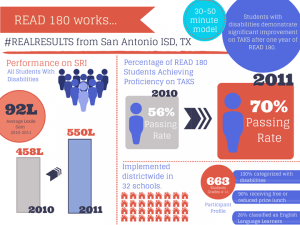Note: The information in this profile represents SY2010-11 unless otherwise indicated.
District Overview
|
District Description
San Antonio Independent School District is the 13th largest district in Texas, with an enrollment of 55,400 students in grades Pre-K through 12. The district began using READ 180 with its high school students in the fall of 2006 and with its elementary and middle school students in the fall of 2009.
Blended Learning Program
|
Program Model
Program model: Station Rotation
Model description
Teachers begin and end each session with whole-group instruction that engages the entire class. In between, students break into groups and rotate through three stations for small-group and independent learning using READ 180.
Program Background
Program description
During the 2010–2011 school year, SAISD implemented READ 180 in 32 elementary, middle, and high schools across the district as an intervention for struggling readers. Selection criteria for participation in the READ 180 program included disability status, Texas Assessment of Knowledge and Skills (TAKS) proficiency level, dyslexia diagnosis, and Response to Intervention (RTI) referral for a Tier 2 or Tier 3 intervention.
Results
A total of 663 students with disabilities were included in the analytic sample: 473 (71 percent) with specific learning disability; 75 (11 percent) with other health impairment; 60 (9 percent) with emotional disturbance; and 55 (9 percent) with different disability subcategories. Data from TAKS and Scholastic Reading Inventory (SRI) were used to measure student achievement for the group.
Data indicated that, on average, students with disabilities enrolled in READ 180 demonstrated improvements in their reading performance. Overall, the READ 180 students with disabilities made a significant gain in their TAKS Reading test passing rate, from 56 percent meeting or exceeding the standard in 2010 to nearly three-quarters of students (70 percent) in 2011. When TAKS results were analyzed for individual disability classifications, students in each major category also demonstrated significant improvements. Students classified as having a specific learning disability or other health impairment achieved average gains of 12 percentage points and 18 percentage points, respectively. Students classified as having an emotional disturbance demonstrated a particularly large average improvement of 23 percentage points. The students with different disability subcategories sample was too small to allow for statistical tests. Additional analyses on the sample of students who did not meet the standard for passing the TAKS in 2010 revealed that more than half of students with disabilities (56 percent) passed TAKS after receiving one year of READ 180.
Analyses revealed that READ 180 students with disabilities also demonstrated significant improvements in performance on SRI . Overall, students with disabilities in SAISD gained an average of 92 Lexile (L) measures. These results were replicated within each disability subcategory that was analyzed; significant average gains were found for students who were classified as having learning disabilities (92L), other health impairment (101L), and emotional disturbance (108L).
The significant gains in achievement on SRI were also evident across grade levels. In the sample of READ 180 students with disabilities, elementary students gained an average of 119L, middle school students gained an average of 92L, and high school students gained an average of 87L.
For more information, see:
“Compendium of READ 180 Research,” Scholastic, 2014,
http://research.scholastic.com/sites/default/files/publications/R180_Compendium_2014.pdf.
Blended Schools
Contact Information
Website: www.saisd.net

